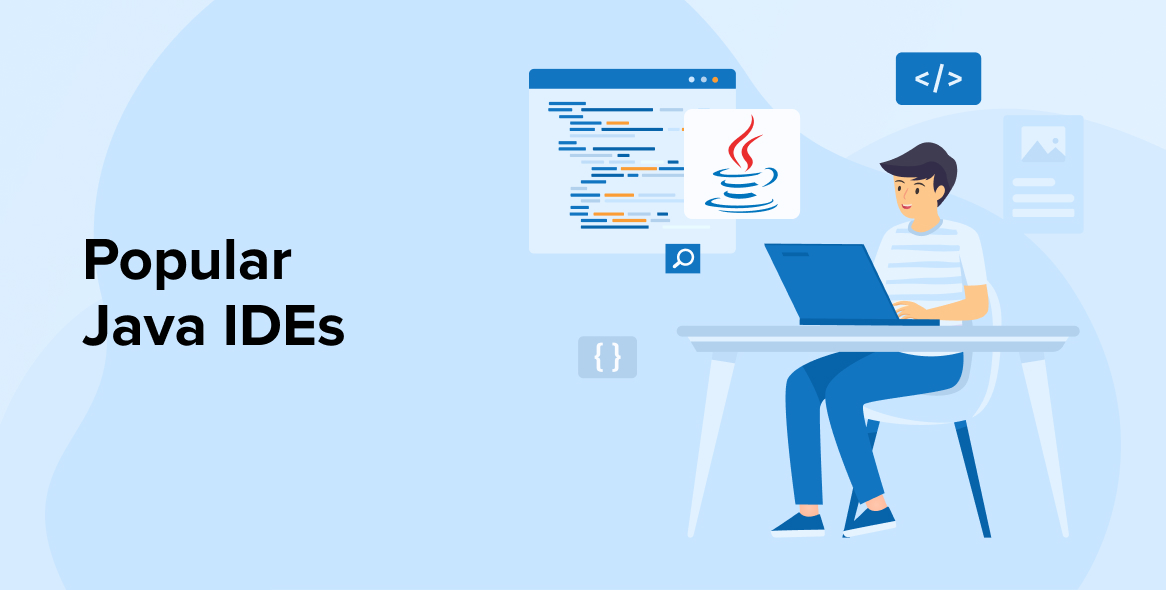Introduction:
Java continues to be a cornerstone of enterprise, mobile, and web development, thanks to its robustness, portability, and rich feature set. In the rapidly evolving tech landscape, Java Integrated Development Environments (IDEs) have become indispensable tools for developers. These IDEs not only enhance coding efficiency but also significantly improve project management, debugging, and testing processes. Let's explore what Java IDEs are and why they are crucial for modern software development.
What are Java IDEs?
Java IDEs are comprehensive software platforms designed to provide developers with an all-in-one solution for coding, debugging, and managing Java applications. By integrating various development tools within a single application, IDEs streamline the development process, making it more efficient and less prone to errors. Features like intelligent code completion, project management tools, and integrated testing environments are key components that define these environments.
10 Best Java IDEs in 2024
Objective: Provide an overview of the top Java IDEs available in 2024.
How to Write: For each IDE listed, follow a structured approach:
IntelliJ IDEA
IntelliJ IDEA remains a leader in the Java IDE market, celebrated for its intelligent code assistance and comprehensive development features. Its popularity is evidenced by its significant market share among professional developers.
Key Features
Renowned for smart code completion that understands context, extensive framework support, and powerful refactoring tools. It also offers advanced debugging and a seamless experience for both front-end and back-end development.
Pros and Cons
Pros: Unparalleled coding efficiency and productivity tools; excellent integration with other tools and frameworks.
Cons: Can be resource-intensive; the learning curve might be steep for beginners.
Pricing: Offers a Community Edition for free; the Ultimate Edition, with extended features for web and enterprise development, requires a subscription.
NetBeans
NetBeans offers a user-friendly approach to Java development, with solid out-of-the-box functionality for Java SE, Java EE, and JavaFX.
Key Features
Features include an intuitive drag-and-drop interface for GUI design, excellent Maven support, and native Git integration.
Pros and Cons
Pros: Straightforward and easy to use; great for beginners and professionals alike.
Cons: Not as customizable as Eclipse; smaller plugin marketplace.
Pricing: Free.
Visual Studio Code
Although not a traditional Java IDE, Visual Studio Code has gained popularity in the Java community for its lightweight, extensible nature.
Key Features
Offers Java support through extensions, excellent code editing and debugging capabilities, and integration with Git and other SCM providers.
Pros and Cons
Pros: Fast and lightweight; highly customizable with extensions.
Cons: Java support relies on extensions, which may not be as integrated as in a dedicated Java IDE.
Pricing: Free.
JDeveloper
Oracle's JDeveloper is geared towards full-stack enterprise application development, offering deep integration with Oracle's technology stack.
Key Features
Strong support for Oracle databases, SOA, and Java EE applications. It includes visual editors and an integrated development framework.
Pros and Cons
Pros: Comprehensive support for Oracle technologies; integrated framework for faster development.
Cons: Primarily tailored to Oracle's ecosystem; might be overwhelming for beginners.
Pricing: Free.
BlueJ
BlueJ is a development environment specifically designed for educational purposes, widely used for teaching object-oriented programming in Java.
Key Features
It offers an interactive interface for visualizing class structures, simple GUI, and integration with educational tools.
Pros and Cons
Pros: User-friendly interface ideal for beginners and educational settings; promotes understanding of object-oriented concepts.
Cons: Lacks some advanced features found in more comprehensive IDEs, making it less suitable for large-scale application development.
Pricing: Free.
Codenvy
Codenvy is a cloud-based IDE that facilitates Java development, allowing developers to code, build, and test apps in the cloud.
Key Features
Offers workspace automation, collaboration features for shared development, and supports Docker environments.
Pros and Cons
Pros: Enables development from anywhere with an internet connection; simplifies collaborative projects.
Cons: Dependency on cloud connectivity can be a limitation for offline development.
Pricing: Offers both free and paid plans, with advanced features available in premium tiers.
DrJava
DrJava is a lightweight IDE primarily designed for students, providing a simple and intuitive interface for Java programming.
Key Features
It includes a powerful code editor, interactive JUnit testing, and a “Read-Eval-Print Loop” (REPL) for evaluating Java code on the fly.
Pros and Cons
Pros: Minimalist design and straightforward functionality make it ideal for beginners and educational purposes.
Cons: Lacks some of the advanced development and debugging tools available in more comprehensive IDEs.
Pricing: Free.
JCreator
JCreator is a powerful IDE for Java developers that offers a faster and more efficient development environment than many traditional Java editors.
Key Features
Features include project templates, code completion, and an integrated debugger. It also boasts a customizable interface and fast compilation times.
Pros and Cons
Pros: Offers a high degree of customization; generally faster than Java-based IDEs due to being built in C++.
Cons: Primarily available only for Windows; the interface might feel outdated compared to other modern IDEs.
Pricing: Available in a Lite version for free; Pro version requires purchase.
Greenfoot
Greenfoot provides an interactive Java development environment designed with educational purposes in mind, specifically for students learning object-oriented programming.
Key Features
It enables easy development of 'actors' which live in 'worlds' to create simulations and interactive games. It also includes tools for sound and image manipulation.
Pros and Cons
Pros: Highly engaging and accessible for beginners, particularly for visual learning and game development.
Cons: Like BlueJ, its functionality is somewhat limited for more advanced or large-scale application development.
Pricing: Free.
Types of IDEs Available
Integrated Development Environments (IDEs) come in various forms, each tailored to meet different development needs and preferences. Understanding the categories of IDEs available can help developers choose the right tool for their projects. Here are the primary types of IDEs, along with examples to illustrate their differences and use cases.
1. General-Purpose IDEs
General-purpose IDEs are designed to support multiple programming languages and frameworks, making them versatile tools for developers working across different technology stacks. These IDEs often come with a wide range of features, including code editing, debugging, and version control integration, applicable to various development scenarios.
Examples:
- Visual Studio Code: Offers support for a broad array of languages and extensions, catering to both frontend and backend development needs.
- Eclipse: Known for its extensive plugin ecosystem, allowing customization for different languages and development frameworks.
2. Language-Specific IDEs
Language-specific IDEs are optimized for development in a particular programming language. They provide advanced features tailored to the language's syntax, libraries, and frameworks, offering deep code analysis, intelligent autocomplete, and specialized debugging tools for efficient coding.
Examples:
- IntelliJ IDEA for Java: Renowned for its intelligent coding assistance, framework support, and productivity-boosting features specifically designed for Java developers.
- PyCharm for Python: Offers powerful tools for Python development, including Django framework support, scientific tools, and a Python profiler.
3. Web-Based IDEs
Web-based IDEs run in the cloud and can be accessed through a web browser, offering the flexibility to code from anywhere with an internet connection. These IDEs facilitate collaboration among distributed teams by allowing multiple developers to work on the same codebase in real-time.
Examples:
- Codenvy: A cloud-based IDE that supports multiple languages and frameworks, offering workspace automation and collaborative features for teams.
- Replit: Provides an instant, collaborative programming environment for various languages, making it ideal for education, rapid prototyping, and smaller projects.
4. Mobile Development IDEs
Specifically designed for mobile app development, these IDEs offer tools and features to streamline the creation of mobile applications. They typically include emulators for testing apps on different mobile devices, as well as integration with mobile development frameworks and libraries.
Examples:
- Android Studio: The official IDE for Android development, offering code editing, debugging, performance tooling, and an emulator for testing Android apps.
- Xcode for iOS: Apple's IDE for developing apps for iOS, macOS, watchOS, and tvOS, featuring a rich set of tools for designing, developing, and debugging applications.
5. Embedded Systems IDEs
These IDEs cater to developers working on embedded systems and IoT devices. They provide specific tools and features needed for developing, testing, and debugging software that runs on hardware devices.
Examples:
- Arduino IDE: Simplifies the process of writing code and uploading it to the Arduino microcontroller board, offering features tailored to IoT projects.
- IAR Embedded Workbench: A comprehensive development environment for embedded development, supporting a wide range of microcontrollers and processors.
Benefits of Using Java IDE
Integrated Development Environments (IDEs) specifically designed for Java offer a multitude of benefits that streamline the development process, enhance code quality, and boost developer productivity. Here are some of the key advantages of using Java IDEs in development projects:
1. Improved Code Quality:
Java IDEs provide real-time feedback and code analysis, detecting potential errors and suggesting fixes as you type. This immediate feedback helps in maintaining high code standards and prevents bugs from entering the later stages of development.
They support coding best practices and enforce project-specific guidelines, ensuring that the codebase remains clean, readable, and maintainable.
2. Efficient Debugging:
Integrated debugging tools allow developers to step through code line by line, inspect variables, and evaluate expressions at runtime. This makes identifying and fixing bugs faster and more intuitive.
Many Java IDEs offer advanced debugging features like conditional breakpoints and thread monitoring, providing deeper insights into the application's behavior.
3. Enhanced Productivity:
Features like intelligent code completion, code generation templates, and quick fixes reduce the amount of manual coding required, speeding up the development process.
IDEs often include integrated build tools and automation features, streamlining the compilation, testing, and deployment workflows.
4. Integrated Development Tools:
Java IDEs come packed with a suite of development tools including version control systems, database management, application servers, and more. Having these tools integrated into the IDE simplifies the development setup and allows developers to manage all aspects of a project from a single interface.
This integration also supports a seamless transition between coding, version control, testing, and deployment tasks.
5. Customization and Extensibility:
Most Java IDEs allow for extensive customization to fit the developer's workflow and preferences, including themes, layout configurations, and shortcut keys.
Extensible plugin ecosystems enable developers to tailor the IDE to their specific needs, adding support for new languages, frameworks, and tools as required.
6. Collaboration and Version Control:
Integrated version control support simplifies team collaboration, making it easy to manage changes, review code, and resolve conflicts within the IDE.
Some IDEs also offer features for pair programming and code reviews, further enhancing collaboration among team members.
7. Comprehensive Project Management:
Java IDEs often include project management tools that help developers organize and manage their work. Features like task lists, code navigation, and project dependency management keep the development process organized and efficient.
Also Read: Task as a Service (TaaS)
Choosing the Best Java IDE for You
Selecting the right Java Integrated Development Environment (IDE) can significantly impact your productivity and the quality of your software projects. With several options available, it's crucial to consider various factors to find the IDE that best fits your specific needs. Here are some key considerations to guide your selection process:
1. Understand Your Project Requirements
- Project Complexity: Larger, more complex projects may benefit from IDEs with advanced code management, debugging, and testing features. Consider IDEs like IntelliJ IDEA or Eclipse that offer extensive support for enterprise-level development.
- Framework and Library Support: If your project relies on specific Java frameworks (such as Spring or Hibernate) or libraries, look for IDEs that provide integrated support or plugins for these technologies, enhancing productivity and ease of use.
2. Consider the Team Size and Collaboration Needs
- Collaboration Features: For team projects, consider IDEs that offer robust version control integration and collaborative coding features. Tools that facilitate easy sharing of code, real-time collaboration, or pair programming can significantly enhance team productivity.
- Consistency Across the Team: Choosing an IDE that supports customization and can enforce consistent coding standards across the team is crucial for maintaining code quality and preventing conflicts.
3. Personal Preferences and Workflow
- User Interface and Usability: The IDE's user interface and overall usability can affect your daily workflow. A user-friendly, customizable interface that aligns with your personal preferences can make development more enjoyable and efficient.
- Performance and Resource Usage: Consider the performance of the IDE, especially if you're working on a less powerful computer. Some IDEs are more resource-intensive than others, which could impact your machine's performance.
4. Evaluate IDE Features in the Context of Your Workflow
- Coding Efficiency Tools: Features like intelligent code completion, refactoring tools, and code templates can speed up development. Evaluate how well these features are implemented and how they fit into your coding habits.
- Debugging and Testing Capabilities: Advanced debugging tools and integrated testing frameworks can save time and improve code quality. Consider how these tools align with your project's testing requirements.
- Plugin Ecosystem: An extensive plugin ecosystem can extend the IDE's capabilities, allowing you to add support for new technologies, languages, and tools as your needs evolve.
- Learning Resources and Community Support: Access to documentation, tutorials, and an active community can be invaluable, especially when transitioning to a new IDE or tackling complex development challenges.
5. Try Before You Decide
- Hands-on Experience: Most IDEs offer free versions or trial periods. Taking the time to use an IDE for a real project can give you a better sense of its fit for your needs than any feature list can.
- Compare and Contrast: If possible, try out a few different IDEs on similar tasks to compare how each fits with your workflow and preferences.
FAQs
1. What makes an IDE suitable for Java development?
A suitable Java IDE should offer comprehensive project management, efficient code editing, debugging tools, and support for common Java frameworks and libraries.
2. Are there free Java IDEs that offer robust features?
Yes, IDEs like Eclipse and IntelliJ IDEA Community Edition provide powerful features for Java development at no cost.
3. How do I choose between IntelliJ IDEA, Eclipse, and NetBeans?
Evaluate based on your project needs, preferred workflow, and the specific features that each IDE offers. Personal trial and user reviews can also guide your decision.
4. Can I use these IDEs for other programming languages besides Java?
Many Java IDEs, especially general-purpose ones like Eclipse and IntelliJ IDEA, support multiple languages through plugins and extensions.
5. What are the system requirements for running these Java IDEs?
System requirements vary by IDE, but most require a modern operating system, a decent amount of RAM (8GB+ recommended), and enough disk space for the IDE and your projects. Higher-spec machines will offer a smoother development experience.





